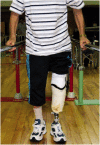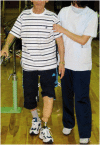Results of prosthetic rehabilitation on managing transtibial vascular amputation with silicone liner after wound closure
- PMID: 27225860
- PMCID: PMC5536617
- DOI: 10.1177/0300060516647554
Results of prosthetic rehabilitation on managing transtibial vascular amputation with silicone liner after wound closure
Abstract
Objective: To investigate the effect of a standardized silicone liner programme on the duration of prosthetic rehabilitation in patients who underwent transtibial amputation as a result of peripheral arterial disease.
Methods: This retrospective study enrolled patients who underwent transtibial amputation followed by one of two stump management programmes at the same rehabilitation centre over a period of 14 years. The study compared the duration of rehabilitation following a standardized silicone liner programme compared with that following a conventional soft dressing programme.
Results: This study included 16 patients who underwent the silicone liner programme and 11 patients who underwent the soft dressing programme. There were no significant differences between the two groups in age, sex, interval between amputation and admission to the rehabilitation centre and stump length. The duration required for the completion of the rehabilitation programme was significantly shorter for the silicone liner programme compared with the soft dressing programme (mean ± SD: 77.3 days ± 13.4 versus 125.4 days ± 66.4 days, respectively).
Conclusion: A standardized silicone liner programme reduced the duration of rehabilitation and could be a valuable replacement for soft dressing-based stump management.
Keywords: Prosthesis; amputation; peripheral arterial disease; rehabilitation; stump management; transtibial; vascular.
© The Author(s) 2016.
Figures




References
-
- Jones WS, Patel MR, Dai D, et al. High mortality risks after major lower extremity amputation in Medicare patients with peripheral artery disease. Am Heart J 2013; 165: 809–815. - PubMed
-
- McWhinnie DL, Gordon AC, Collin J, et al. Rehabilitation outcome 5 years after 100 lower-limb amputations. Br J Surg 1994; 81: 1596–1599. - PubMed
-
- Stone PA, Flaherty SK, AbuRahma AF, et al. Factors affecting perioperative mortality and wound-related complications following major lower extremity amputations. Ann Vasc Surg 2006; 20: 209–216. - PubMed
-
- Fletcher DD, Andrews KL, Hallett JW, Jr, et al. Trends in rehabilitation after amputation for geriatric patients with vascular disease: implications for future health resource allocation. Arch Phys Med Rehabil 2002; 83: 1389–1393. - PubMed
MeSH terms
Substances
LinkOut - more resources
Full Text Sources
Other Literature Sources

